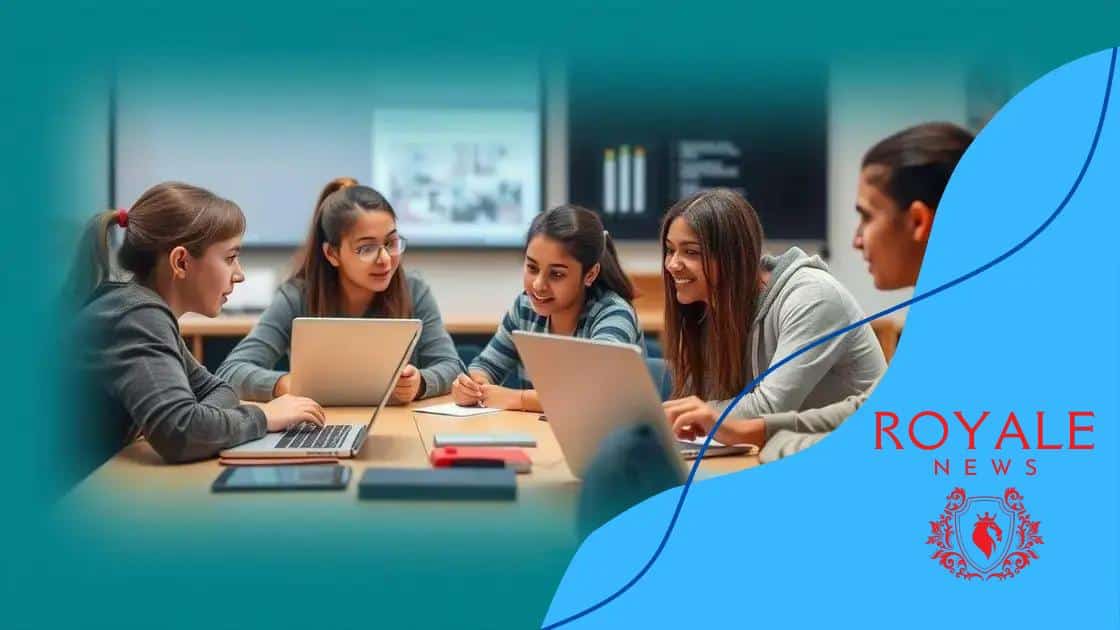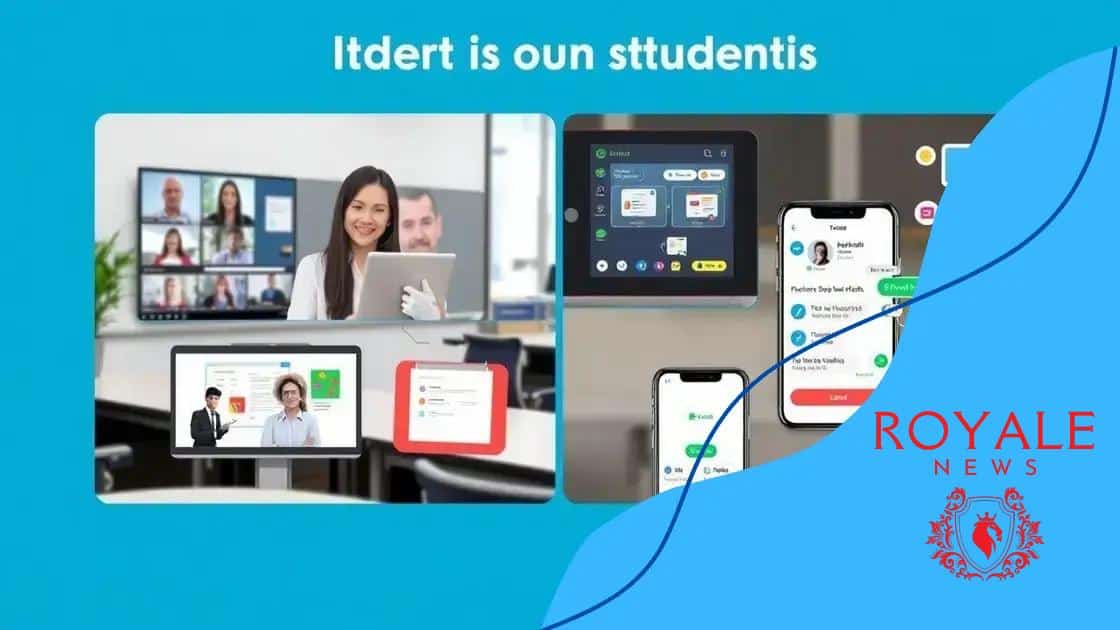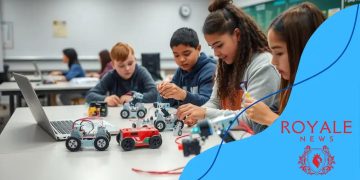The impact of virtual classrooms on student collaboration

The impact of virtual classrooms on student collaboration enhances engagement and teamwork through interactive tools, personalized learning, and global connectivity, while also posing challenges such as miscommunication and technical issues.
The impact of virtual classrooms on student collaboration is a topic that has gained attention in recent years. As education evolves, online learning environments present unique opportunities for students to engage with each other. Have you ever wondered how these setups enhance teamwork skills?
Understanding virtual classrooms
Understanding virtual classrooms is essential in today’s educational landscape. These online environments provide unique opportunities for students to learn collaboratively from anywhere in the world. With the rise of technology, the way we approach education has changed dramatically.
Key Features of Virtual Classrooms
Virtual classrooms come with several key features that enhance the learning experience:
- Live video interactions between teachers and students.
- Accessible resources and materials available at all times.
- Interactive tools such as polls and quizzes to promote engagement.
By leveraging these features, educators can create a more dynamic and interactive experience for their students. One significant advantage is the ability to connect with peers globally. This connection fosters a diverse learning environment where ideas can be shared freely.
Benefits of Virtual Classrooms
Many students find that virtual classrooms provide a comfortable and flexible way to learn. They can study from home or any location that suits them best. As a result, this flexibility can lead to improved focus and productivity.
Additionally, virtual classrooms often allow for personalized learning. Students can progress at their own pace, whether they need more time on a challenging topic or they are ready to move forward quickly. These adaptations make education more accessible and tailored to individual needs.
Furthermore, engaging with digital tools helps students become familiar with technology that is increasingly essential in the workforce. By participating in virtual classrooms, they gain valuable skills that will serve them well in their future careers.
In conclusion, understanding virtual classrooms reveals how they transform the educational experience. Their innovative approach fosters collaboration, accessibility, and technological fluency for students.
Benefits of virtual classrooms for collaboration
The benefits of virtual classrooms for collaboration are numerous and significant. These platforms create opportunities for students to work together, even when they are physically apart. By engaging in virtual learning, students can easily share ideas and resources.
Enhanced Communication
In a virtual classroom, communication is key. Students have access to various tools that facilitate discussions. This includes:
- Chat features that allow real-time conversations.
- Video calls for visual interactions.
- Discussion boards for thoughtful reflections.
These tools empower students to express their thoughts in different ways, fostering a more inclusive environment. Such platforms encourage younger students, who may feel shy to speak up in person, to share their ideas comfortably online.
Collaboration Tools
Another major advantage is the variety of collaboration tools available. These can enhance the educational experience significantly. Virtual classrooms often feature:
- Shared documents and presentations for group projects.
- Virtual whiteboards for brainstorming sessions.
- File-sharing capabilities to facilitate access to resources.
By utilizing these tools, students can work together more effectively. They can contribute equally to projects and problem-solving activities, leading to a higher quality of work.
Furthermore, collaborative online activities help students develop essential teamwork skills. Learning how to work with others prepares them for future work environments where collaboration is crucial.
In summary, the benefits of virtual classrooms for collaboration empower students to engage, communicate, and work together efficiently. By embracing these technologies, educators can enhance the learning experience, making it more interactive and valuable for all involved.
Tools that facilitate student interaction

Tools that facilitate student interaction are essential in modern virtual classrooms. These tools help create a more engaging and collaborative learning environment. With a wide range of digital resources available today, students can connect with their peers and teachers more effectively.
Types of Interaction Tools
There are many types of tools designed for this purpose. Some of the most effective include:
- Video conferencing software that allows for real-time discussions.
- Interactive whiteboards where students can collaborate on projects.
- Messaging platforms that enable quick communication between students and teachers.
These tools ensure that students feel supported and part of a learning community, even when they are not in the same physical space.
Benefits of Interaction Tools
Utilizing these tools comes with numerous benefits. First, they enhance engagement by making learning more interactive. Students are more likely to participate when they can share their ideas easily. Additionally, these tools help develop important digital skills that are vital in today’s workforce.
Moreover, platforms that allow for collaborative work also encourage teamwork. For instance, through online group projects, students learn how to communicate effectively and combine their strengths to achieve common goals. This experience not only enriches their learning but also prepares them for future collaborative efforts in their careers.
As we consider the role of these tools, it’s clear that they are pivotal in fostering an interactive and supportive educational environment. By integrating effective tools for interaction, students can thrive in virtual classrooms and make the most of their collaborative learning experiences.
Challenges of online collaboration
Collaboration in virtual classrooms brings many benefits, but there are also significant challenges of online collaboration. Understanding these challenges is crucial for creating effective learning experiences.
Common Challenges
One major challenge is the potential for miscommunication. When students collaborate online, they often miss the nonverbal cues that are present in face-to-face interactions. This can lead to misunderstandings about project expectations and roles.
- Time zone differences can hinder real-time collaboration, especially for students in different geographical locations.
- Technical issues, such as poor internet connectivity or software glitches, can disrupt group work.
- Feelings of isolation may arise, making it harder for students to connect on a personal level.
These obstacles can reduce the effectiveness of group projects and limit the overall educational experience.
Strategies to Overcome Challenges
To address these challenges, it’s important to implement strategies that promote effective collaboration. Setting clear guidelines can help manage expectations. Students should know their roles and responsibilities within the group. Regular check-ins through video conferencing can also strengthen communication.
Incorporating icebreakers or team-building activities at the start of projects can break down barriers and foster a sense of community. Additionally, encouraging students to use a variety of communication tools can help mitigate the effects of miscommunication. Tools like chat applications and collaborative documents allow for ongoing conversation and clarity.
Ultimately, understanding the challenges of online collaboration is vital to fostering a productive learning environment. By addressing these challenges head-on, educators can help students navigate the complexities of working together in a virtual setting.
Future trends in virtual education
The future trends in virtual education are promising and exciting. As technology continues to evolve, so do the methods of teaching and learning. This evolution aims to enhance the educational experience for students everywhere.
Growth of Interactive Learning
One significant trend is the move towards more interactive learning. This involves using advanced technologies, such as virtual reality (VR) and augmented reality (AR). These tools provide immersive experiences that can captivate students’ attention and enhance understanding.
- VR can transport students to historical sites or outer space, creating engaging learning experiences.
- AR can overlay digital information on the physical world, making lessons more relatable.
- Interactive simulations can provide hands-on experiences in subjects like science and math.
This shift towards interactivity not only keeps students engaged but also helps them grasp complex concepts more easily.
Personalized Learning
Another trend is the rise of personalized learning. With data analytics and AI, educational platforms can adapt to each student’s individual learning pace and style. This customization can significantly improve student outcomes. By recognizing strengths and weaknesses, virtual education can offer tailored resources that suit each learner.
Additionally, personalized learning encourages students to take charge of their education. They can choose what to study and when to study it, fostering a sense of independence and motivation.
Moreover, the use of artificial intelligence in virtual classrooms allows for on-demand assistance, making learning more accessible. Students can receive help when they need it, rather than waiting for designated class times.
As we look ahead, the future trends in virtual education indicate a shift towards a more engaging, personalized, and interactive experience. Embracing these trends will be essential for educators aiming to prepare students for success in a rapidly changing world.
FAQ – Frequently Asked Questions about Virtual Classrooms and Student Collaboration
What are virtual classrooms?
Virtual classrooms are online environments that allow students and teachers to interact, share resources, and participate in learning activities remotely.
How do virtual classrooms enhance student collaboration?
They provide tools like video conferencing, chat features, and shared documents, which promote communication and teamwork among students.
What challenges do students face in virtual collaboration?
Common challenges include miscommunication, technical issues, and feelings of isolation, which can hinder effective group work.
What trends are shaping the future of virtual education?
Future trends include the growth of interactive learning technologies, personalized learning experiences, and increased use of artificial intelligence to assist learners.





